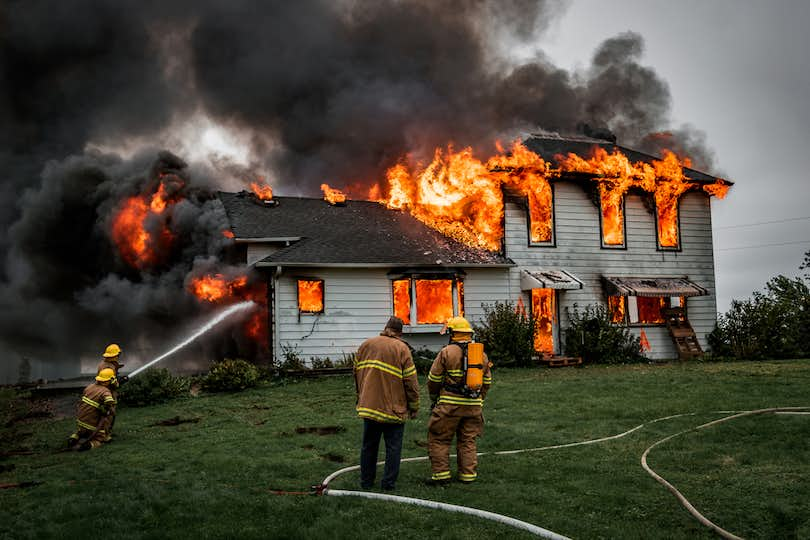
I’ve held many different titles in my 50-plus years, but none more important than "firefighter." Even though I retired from it 10 years ago, I always bring that passion for fire safety to my real estate clients.
The good news is that today's home builders and contractors use more fire-resistant, safer materials than ever. They no longer use the past hazardous balloon-frame wood construction and knob-and-tube wiring.
For example, today's ubiquitous drywall (gypsum) delays fires from spreading due to its water content of 20%. And today's interior doors can typically hold off a fire for up to 45 minutes – which is why you should close your bedroom door at night.
Unfortunately, despite all the improvements, dangers remain in most American homes.
The National Association of Home Builders and other groups continue to lobby against more safety provisions, such as mandatory sprinklers in new single-family homes, mostly due to cost.
Also, today's home builders commonly use lightweight wood roof trusses with an Achilles heel: They can collapse quickly and unexpectedly in fires, endangering occupants and firefighters.
It's important for homeowners to be aware of fire hazards in their homes – and to take steps to improve their home's safety whenever possible. Here are seven key dangers to check in your own home.
1. Do you have the right smoke detectors?
First, here’s the good news: An estimated 96% of American homes have at least one smoke detector, according to the U.S. Fire Administration and the National Institutes of Science and Technology.
However, 90% of smoke detectors are a less effective type – and they cost lives each year.
The National Fire Protection Association says about 100 million U.S. homes rely on ionization smoke detectors, which don't work as well as the more expensive photoelectric sensors.
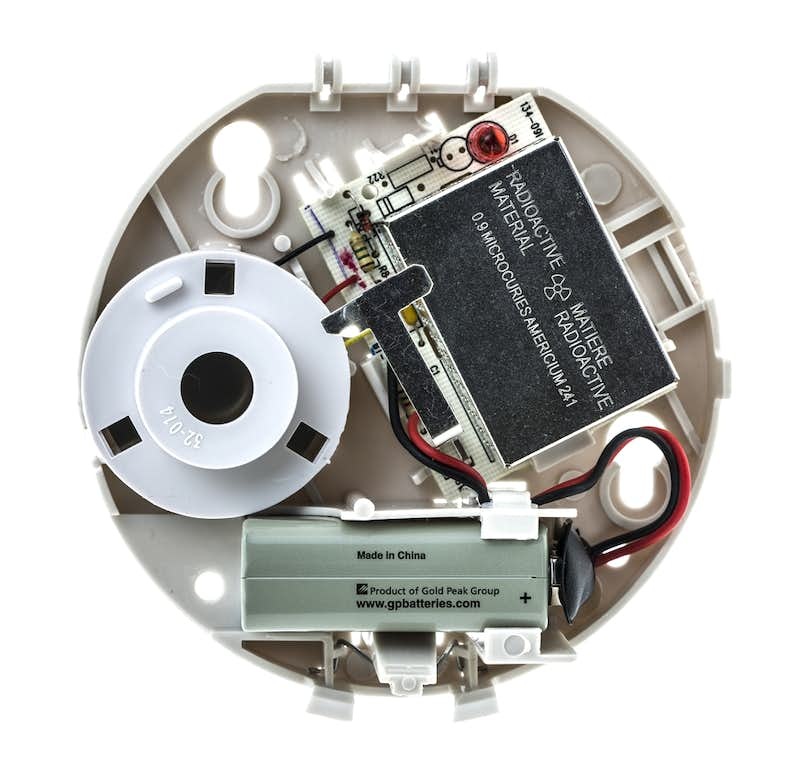 Ionization detector with its cover off
Ionization detector with its cover off
Ionization detectors use a tiny amount of radioactive material to trip the alarm when it senses small burning particles. They work well enough with fast-spreading kitchen fires, but they are less able to detect slow-burning or smoldering fires caused by common culprits like cigarettes, frayed appliance wires, and fireplace sparks.
As many as 30,000 people in the U.S. have died since 1990 because they relied on ionization detectors, according to Joseph Fleming, a fire consultant and deputy chief at the Boston Fire Department. That’s because an ionization alarm can take 20 to 50 minutes longer to activate than a photoelectric smoke alarm.
Fleming’s analysis of Massachusetts fire deaths determined that ionization alarms contributed to about half of the deaths. He concluded that switching to photoelectric alarms should reduce fire deaths by about 35%.
So why do so many homes have ionization alarms in the first place?
Answer: They’re generally cheaper. Depending on the brand and features, they can be half the price of a photoelectric model, typically costing $30 to $80 at retail. Also, the battery on an ionization alarm tends to last longer.
Besides taking longer to activate in slow-burning fires, ionization models also have another problem: high false alarm rates. Cooking and showering can trigger them, prompting many people to disconnect their ionization alarms. Photoelectric alarms, which use a beam of light to sniff out larger burning particles, have fewer false alarms.
Also, by the time an ionization alarm activates due to an actual fire, smoke and carbon monoxide levels are likely to have built up sufficiently to disorient you and make you unable to exit your home.
Bottom line: Ensure that the only place you have an ionization alarm is in your kitchen, which tends to have faster-burning fires. Use photoelectric detectors in bedrooms, hallways, and other house areas. Ideally, they should be hardwired with a battery backup so if one alarm sounds, they all will sound.
If your house doesn’t have hardwired smoke detectors, get a 10-year sealed lithium battery detector. In many jurisdictions, 9-volt standalone detectors are no longer acceptable.
2. Lightweight roof trusses
 Lightweight wood roof truss with metal gussets
Lightweight wood roof truss with metal gussets
Today's builders commonly use lightweight wood roof trusses instead of the rafters of years past. However, fire officials have contended for years that these trusses can collapse quickly in fires and endanger lives.
These trusses, present in 66% of American homes, are cost-efficient and strong in most situations – except for fires.
Fire experts have long warned that the heat from fires can pop off the metal gussets that connect the wood, collapsing the roof. These connectors have teeth on one side that sink into the wood without using nails, staples, screws or bolts. So instead, truss companies build them off-site, with machines pressing the plates into place against the lumber. Builders like the lower cost, and building codes typically allow them.
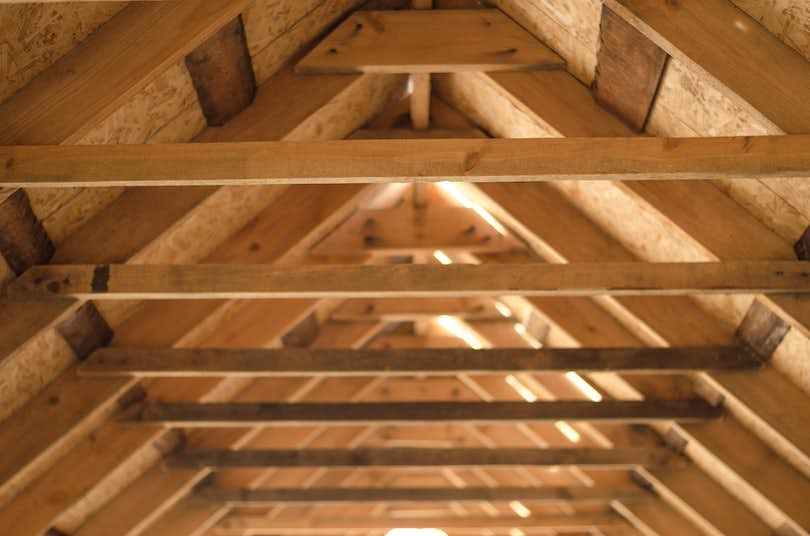 Wood rafters, also called stick construction
Wood rafters, also called stick construction
Older homes typically have wood rafters, also called stick construction, instead of trusses. So do some new homes. Builders constructed rafters on-site for many years until wood trusses came into widespread use. Builders and others point to the advantages of trusses, including weight distribution, quality control, speed of manufacture, and lower cost.
Roof collapses caused by fires have been in the news for years. In 2018, a firefighter in Howard County, Maryland, died after he fell through the floor of a home with lightweight trusses that had been burning for more than an hour. Because it was a single-family home, it wasn’t required to have sprinklers, unlike many townhomes or condos built with wood trusses.
In January 2013, firefighters of the Manhasset-Lakeville Fire Department in New York responded to a fire in a home's basement. They had to evacuate within minutes when the first floor started separating from the house. The first floor collapsed into the basement within 45 seconds of the last firefighter evacuating.
As a result of the close call for firefighters in New York state, then-Gov. Andrew Cuomo signed a bill into law in October 2014 that requires a truss notification system on all new construction homes in the state. Still, the construction industry has opposed creating a national truss identification system.
As a result, many fire departments won’t risk fighting a fire inside the home unless an occupant's life is in danger. Unfortunately, that often means your home will sustain more water damage because firefighters use more water to spray it from outside.
Many residential building codes now require sprinkler systems for homes with trusses. However, sprinklers add to the home's cost and run the slight risk of being accidentally set off, damaging the house and its contents.
What can a homeowner do about all of this? Unfortunately, not much. Just be aware and practice good fire safety in your home, as everyone should.
And if you're unsure about your home's roof construction, you or someone else can climb (safely, of course) into the attic to check.
3. Gas lines using corrugated stainless steel tubing
More than two million U.S. homes have a type of gas piping known as corrugated stainless steel tubing, or CSST, which is thinner, more flexible and cheaper but is also more susceptible to damage due to lightning strikes.
A lightning bolt can burn holes in the tubing and cause a fire from leaking natural gas or even a catastrophic explosion. In 2007, homeowners settled a class-action lawsuit against the makers of several gas lines that were found to be insufficiently resistant to lightning strikes.
The widow of the previously mentioned Maryland firefighter settled a lawsuit in June with the maker of the CSST piping. The suit claimed the company continued to sell the product, knowing it was a factor in more than 75 lightning-induced fires.
Bottom line: If you have a home with CSST, have it replaced by a licensed plumber.
In addition, if your house was built between 1860 and 1915, you may have lines in the walls that once supplied natural gas for lighting.
Some lines have been capped off, and others have been converted to electric, but some are still active and potentially dangerous. For example, an active gas line in one home was used as a towel rack, according to this website for home inspectors.
Make sure you know what’s behind a wall before you drill!
4. Aluminum wiring and Stab-Lok breaker panels
Builders and electricians commonly used aluminum wiring from the 1950s to the 1980s. Unfortunately, it oxidizes over time at connections such as the outlets, switches, and breaker panels, creating a fire hazard.
Aluminum wiring also expands and contracts due to its lower conductivity, creating heat and loosening connections. In addition, inexperienced electricians would strip the softer aluminum wiring the same way they stripped the more resilient copper wiring, which would lead to nicks that eventually became breaks.
Have you ever seen scorching around an outlet or light switch? Or smelled a metallic burning odor when you flipped a switch? That could be from aluminum wiring.
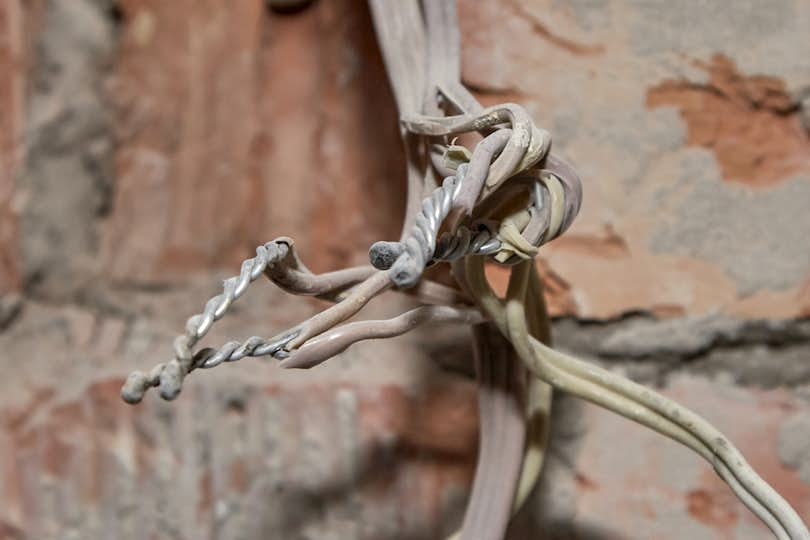 Old aluminum wiring
Old aluminum wiring
A homeowner or inspector can identify aluminum wiring by looking at the wires and breaker panel. You'll see "AL" stamped on the wires and sometimes on the electrical panel itself. The Federal Pacific Electrical Company (FPE) manufactured many of these "Stab-Lok" breaker boxes, which were installed from the 1950s to the 1980s.
The "Stab-Lok" panel got its name from the breakers "stabbing" into the bus bar in an overload and "locking" into place. But the breaker design often failed to trip – causing fires. Importantly, aluminum wiring and the FPE panels were typically installed together. So a good home inspector or electrician will tell you that if there’s an FPE breaker panel, you probably have aluminum wiring.
You need to remove aluminum wiring or replace the connections with "pigtails" that join copper and aluminum wiring. Unfortunately, rewiring a house can cost as much as $8,000 to $10,000. But considering that a home insurer typically won’t underwrite a policy for a place with aluminum wiring, you may not have an option.
5. Knob-and-tube wiring and ungrounded 2-prong outlets
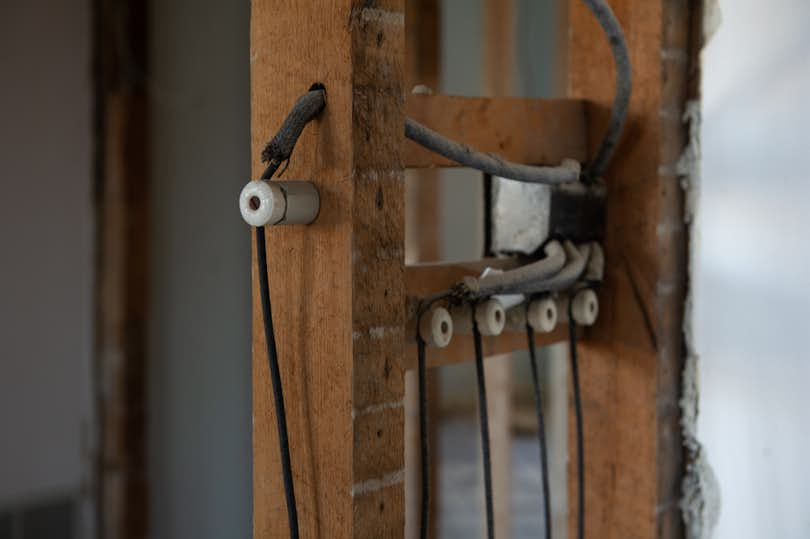 Knob-and-tube wiring
Knob-and-tube wiring
Encountering a house with ceramic knob-and-tube wiring is rare these days, but they still exist. You’ll only find it in homes built in the late 1870s through the early 1900s.
Knob-and-tube wiring was used before the advent of refrigeration and appliances, so it wasn't designed to handle the necessary amperage. As a result, wires without grounds can cause fires if the circuit gets overloaded. One signal of a home containing knob-and-tube wiring is the presence of two-pronged electrical outlets which don’t have a third prong for a ground wire.
In addition, the wiring was strung freely inside voids to allow the heat to dissipate, but it's compromised when insulation surrounds it. Over time the wires can sag and come into contact with plumbing and other building materials, allowing heat to build up and causing fires. The wires are also particularly vulnerable to moisture and can cause electrical shocks when wet.
Bottom line: Knob-and-tube wiring is a dangerous Victorian-era relic that a licensed electrician should replace or make safe.
6. Electric space heaters
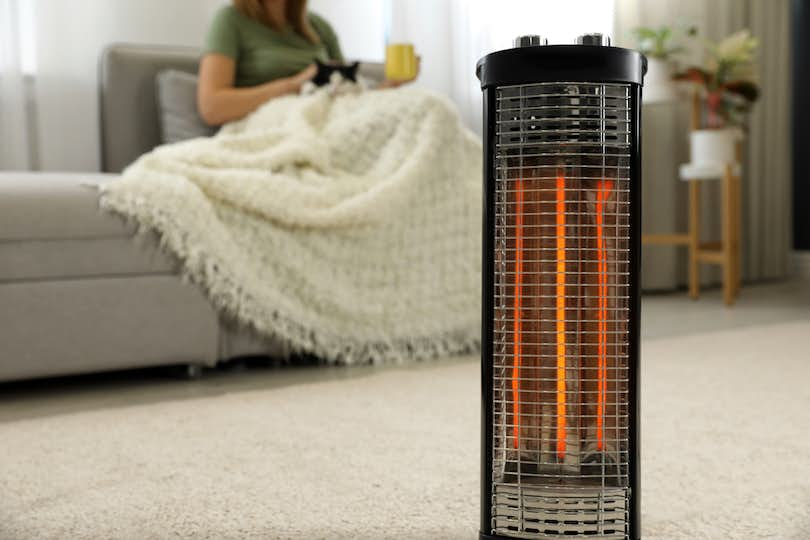 Electric space heater
Electric space heater
Electric space heaters are convenient and helpful when you need a little extra heat to warm up a chilly basement, home office or bathroom on a cold morning. Contractors also use space heaters to cure drywall and speed evaporation in cold weather.
But they’re also an extreme fire hazard. The NFPA says that one out of SEVEN fires in the home (more than 45,000 a year) are caused by malfunctioning heating equipment, and more than 80 percent of the 500 fatalities a year involved portable space heaters. Indeed, 17 people, including eight children, were killed in January of 2022 when a fire swept through an apartment in New York’s Bronx neighborhood. The fire was blamed on a malfunctioning space heater.
The dangers of space heaters are both obvious and hidden. For one, they draw a lot of amperage, which if you’ve been reading this piece, doesn’t play well with outdated wiring. Amps mean heat, And if your wiring isn’t able to handle the draw from a space heater, you could be looking at a fire.
Space heaters must have automatic shutoffs and tip-over shutoffs, but that doesn’t help when a blanket or drapery contacts the heating element and starts a fire. The NFPA noted that more than 50% of home heating fire deaths resulted from contact with the heating element of a portable heater.
Bottom line: Avoid using space heaters in rooms where people are sleeping or where they are left unattended while running.
7. Overloaded outlets and power strips
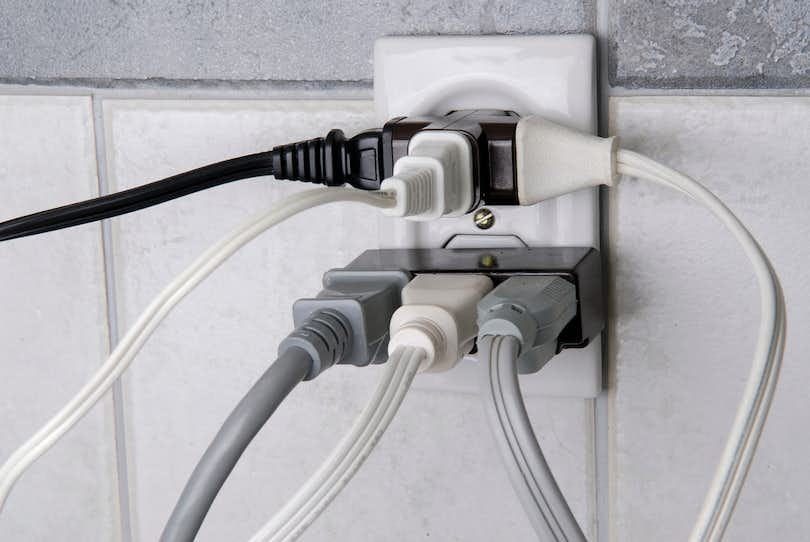 Too many plugs in an electrical outlet
Too many plugs in an electrical outlet
Do you know someone who plugs way too much into outlets and power strips? I bet you do. This is one of the most common home fire hazards.
Even Hollywood has taken notice. For example, you may have seen the movie "A Christmas Story" where the father (Darren McGavin) plugs his "Major Award" into an overloaded, ungrounded, two-pronged outlet. Or when the father in "Christmas Vacation" (Chevy Chase) blacks out the whole city with his overloaded Christmas light setup?
Not to be a killjoy here, but the reality is that electrical problems such as overloaded circuits can lead to tragedy. Any plug or wire that’s hot to the touch is overloaded beyond its capacity. A sharp, acrid smell means the wire is hot enough to burn its insulation. So replace it as soon as possible.
Power strips also can be a fire hazard. They're often overloaded or placed where heat can’t dissipate. Power strips aren't designed to handle high-amperage appliances. They handle lower-amp items like computers, lights, and alarm clocks.
In addition, plugging one power strip into another, or "daisy-chaining," is particularly dangerous as it can cause a short beyond the capacity of the internal circuit breaker.
Finally, never use a power strip in a kitchen or basement where moisture is present. And if a power strip is hot to the touch, unplug it immediately.
Other common home fire hazards
Here's a quick checklist of other common home fire risks. People cause these fires through unsafe behavior:
- Smoking when you might fall asleep
- Improperly storing gasoline, propane, solvents or other flammable materials
- Barbecuing too close to your house
- Using a fire pit too close to your home
- Leaving your stove unattended while cooking
- Leaving a sparking fireplace unattended
Final thoughts from a former firefighter
Many of us think of our homes as sanctuaries. We want them to be safe and secure. But often, we may not be aware of the dangers around us. Other times, we're vaguely aware but aren't careful. If this article prompts you to make your home safer, I've done my job. Once a firefighter, always a firefighter.
"The funny thing about firemen is...night and day they are always firemen."
-- Donald Sutherland as an arsonist in the movie "Backdraft"
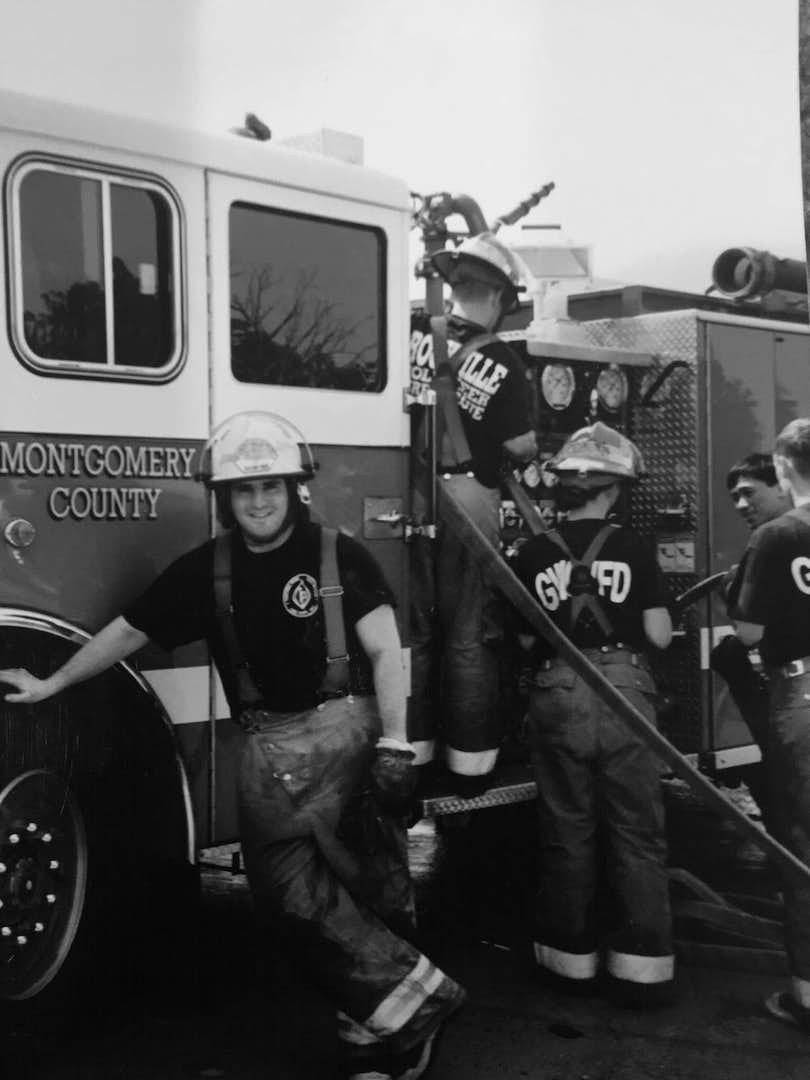
Daniel Goldstein, back in his firefighter days in Montgomery County, Maryland

